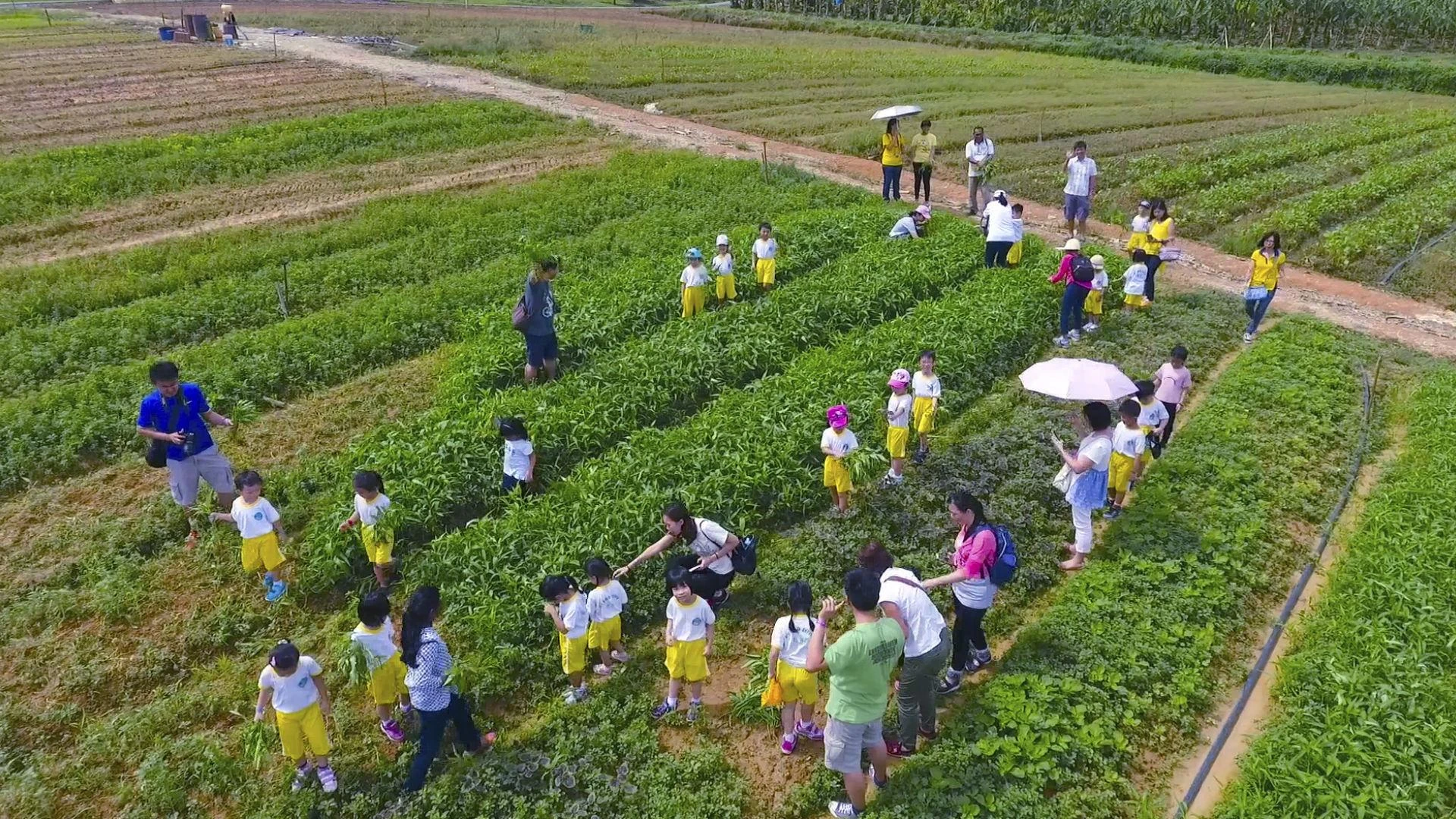Many people dream of turning their passions into profit. Those who love farming and hosting might see agro-tourism as ideal.
Yet, the question looms—how profitable can it really be? The global agritourism market was worth $69.24 Billion in 2019 and is on track to hit $117.37 Billion by 2027. This growth indicates a thriving opportunity.
Our article explains how to profit in agro-tourism. It covers the basics and the importance of hospitality. We also look at financial effects. These include revenue growth and profit margins. Finally, we explore how COVID-19 has changed visitor preferences.
Discover insights that could turn your farm into more than just a place for planting but also a destination for learning, relaxation, and adventure. Keep reading; you might find the key to unlock this lucrative door.
Key Takeaways
- Agro-tourism combines farming with vacationing to offer unique experiences like picking fruits and feeding animals. This industry grew from $69.24 Billion in 2019 to a projected $117.37 Billion by 2027, showing strong growth.
- Farms adding agro-tourism can see profits between $10,000 and $100,000 annually from activities like tours and farm stays due to increased visitor interest in sustainable travel and authentic experiences.
- The COVID-19 pandemic changed how people view vacations, increasing interest in agro-tourism for safer outdoor activities and teaching businesses the importance of online engagement through virtual tours.
- Adopting agro-tourism helps farms diversify income sources beyond traditional farming, supports local economies through job creation and community support programs, and promotes environmental conservation efforts.
- Looking forward, the future of agro-tourism is bright with growing market value expected to reach $117.37 billion by 2027 as more farmers look for innovative ways to blend agriculture with leisure activities for eco-friendly tourism options.
Understanding the Concept of Agro-tourism

Agro-tourism combines farming and vacationing. It offers visitors a peek into farm life. Guests enjoy activities like picking fruits, feeding animals, and learning about sustainable practices.
This blend gives tourists a unique experience while helping farms earn extra money. Farms become tourist attractions. People go there to connect with nature and learn where their food comes from.
This trend is growing as farmers look for ways to diversify their income. Agritourism markets are growing worldwide. This makes it an intriguing option for farmers.
With the right approach, these businesses can make a lot of money. They do this by attracting people interested in organic products. They also attract those interested in conservation efforts and rural life.
Agro-tourism not only supports local economies but also promotes environmental awareness among visitors.
Benefits of Diversifying Farms with Agro-tourism
Now that we\'ve explored what agro-tourism is, let\'s dive into its benefits for farmers. Diversifying farms through agro-tourism can bring several advantages.
- Increased Income: Farms adding tourism to their business often see a boost in earnings. They make money not just from crops or livestock but also from guests visiting their farm. This diversification can lead to substantial profit margins, as shown by farms reporting profits between $10,000 and $100,000 from agritourism.
- Market Expansion: Through targeted marketing and social media marketing, farms reach out to new customers. They tap into the tourism industry and attract people interested in sustainable farming and organic produce.
- Brand Awareness: Hosting visitors helps build a farm’s brand without heavy advertising costs. Word of mouth, online reviews, and social media sharing by visitors spread the word fast.
- Educational Opportunities: Farms offer tours and workshops on sustainable farming practices or food systems. This educates the public and raises awareness about agriculture\'s importance.
- Conservation of Biodiversity: By showcasing practices like crop rotation or agroforestry, farms highlight their role in biodiversity conservation. Visitors learn how these methods support a healthier planet.
- Community Support: Agro-tourism generates revenue that stays in local communities. It supports local food systems by encouragingthe consumption of local produce.
- Resilience Against Market Fluctuations: When crop prices drop or unpredictable weather strikes, income from tourism provides a cushion for farmers. This financial stability supports ongoing agricultural operations despite market challenges.
- Job Creation: As tourism activities grow, farms need more hands on deck—creating jobs for guides, hospitality staff, or event coordinators within rural communities.
- Cultural Exchange: Farmers share their way of life with visitors from different backgrounds—a mutual exchange where both sides learn and grow.
Each benefit aligns with goals for sustainability and economic growth. This makes agro-tourism an attractive option for modern farmers. They want to expand beyond traditional farming methods.
Factors Driving the Adoption of Agro-tourism

Agro-tourism is growing fast. Farmers see it as a smart way to make more money from their land.
- Interest in Sustainable Tourism: People today want travel experiences that help protect the environment and support local communities. Agro-tourism fits this bill perfectly, letting guests enjoy nature while learning about organic farming and sustainable living.
- Desire for Authentic Experiences: Tourists are looking for real, meaningful experiences. They want to see where their food comes from, learn how to harvest crops, and even take part in traditional farming practices. This desire drives them straight to agro-tourism destinations.
- Economic Incentives for Farmers: The U.S. Department of Agriculture (USDA) offers incentives to farms that provide educational experiences related to agriculture. These benefits make it easier for farmers to start agro-tourism ventures.
- Digital Marketing Reach: Online advertisements and social media platforms have made it easier than ever for farms to reach their target audience. A well-made website or an engaging Instagram account can attract tourists from all over the world.
- Urbanization: As cities grow, so does the gap between urban dwellers and their understanding of farm life. Agro-tourism serves as a bridge, offering city folks a chance to connect with rural life and understand where their food originates.
- Consumer Awareness: More people want to know about the food they eat—whether it\'s organic, GMO-free, or locally sourced. Agro-tourism allows visitors to see first-hand how food is produced and learn directly from farmers.
- The Pandemic\'s Impact: COVID-19 has changed how people think about vacations. Many now prefer outdoor activities with fewer crowds, which has boosted interest in agro-tourism places where they can enjoy open spaces safely.
- Global Market Growth: With the global agro-tourism market projected to expand significantly, entrepreneurs see great potential in this area for investment and growth.
- Community Support Programs: Initiatives like community-supported agriculture (CSA) programs build direct connections between farmers and consumers, encouraging more visits to farms and participation in agro-tourist activities.
- Educational Opportunities: Schools and universities often look for real-world examples of sustainable practices and healthy eating strategies—agro-tourism sites provide these educational opportunities.
Farms worldwide see these factors as key. They are reasons to dive into agro-tourism. It\'s a smart business move. It also enriches communities culturally and economically.
Financial Impact of Agro-tourism
Agro-tourism boosts farm income. It does this by adding new revenue sources, like tours and product sales. The mix reduces the economic risk for farmers. Farmers can see steadier profits throughout the year.
Revenue Growth
Farms that add agro-tourism see their earnings rise. The global agro-tourism market grew from $69.24 Billion in 2019 to a projected $117.37 Billion by 2027. This shows a strong yearly growth rate of 7.42%.
Farmers offering tours, stays, and other experiences tap into new income streams.
Most farms report making between $10,000 and $100,000 annually from these activities. They attract visitors to explore farming and local produce. This earns them more and diversifies their income.
This shift helps secure the farm\'s finances. It protects them against unpredictable crop yields and market prices.
Profit Margin
Agro-tourism businesses see a wide range of profit margins. Most farms make between $10,000 and $100,000 from these activities. This shows that combining farming with tourism can really pay off.
Some places earn even more, proving agro-tourism is a strong way to increase earnings.
The global market for this business is growing fast, from $69.24 billion in 2019 to a projected $117.37 billion by 2027. This growth means there\'s big potential for making money in agro-tourism.
Every farm has different results. But, many report good profits. They earn them from welcoming visitors and sharing the farming experience with them.
Key Insights on Agro-tourism Market Trends
The global agro-tourism market is booming, expected to hit $117.37 billion by 2027, with a growth rate of 7.42%. This surge shows that more people are eager to farm and explore the countryside.
Farmers have found a gold mine. They combine farming with tourism. This has led to more money and diverse income. Countries across Asia and in developing areas are quickly adopting agro-tourism. This shows a shift to more sustainable and experiential travel.
An interesting trend emerges from the analysis. Farms in less favored regions may struggle to profit from agro-tourism alone. Still, the sector has many opportunities. Entrepreneurs can merge nature tourism with farming.
Tailor marketing strategies for tourist hotspots. They can boost profits a lot. Success needs a website. So, focus on digital presence. Next up - how hospitality plays into building fruitful agro-tourism ventures.
Role of Hospitality in a Successful Agro-tourism Business
Hospitality plays a key role in agro-tourism success. The friendly service makes guests feel at home. It encourages them to return or recommend the business to others. Effective communication is crucial. So are attentiveness to guest needs and providing a unique visitor experience.
Hospitality goes beyond basic service. It involves creating an environment. Visitors can learn about farming, taste local produce, and join in farm activities.
This hands-on approach improves the visitor experience. It promotes positive word-of-mouth and repeat visits.
Training staff in hospitality principles is vital. It is key for an agro-tourism enterprise\'s reputation and growth. Employees should understand how their actions contribute to the guest\'s experience and satisfaction.
The services are personalized. They include guided tours of the farms. You also get special tastings of products like wines from on-site vineyards. These things add value. Customers appreciate and remember them.
Also, keeping facilities clean and safe does more than meet guest expectations. It exceeds them. It sets a high standard for hospitality in agro-tourism.
Influence of COVID-19 on the Agro-tourism Market
After exploring the importance of hospitality, it\'s clear that external factors can deeply impact agro-tourism. COVID-19 is one such factor that turned the market upside down. The global outbreak forced many countries into lockdowns.
These lockdowns hit farmers and tourism hard. People couldn\'t visit farms. This meant no income from agritourism for a while.
The pandemic taught agro-tourism businesses to adapt quickly. They started using online platforms to connect with their audiences. Virtual farm tours became popular. These changes helped some farms stay afloat during tough times.
As restrictions eased, people started visiting farms again. They now expect safer environments and social distancing measures.
Case Study: Profitability of Agro-tourism Farm Stay Businesses
Despite the setbacks from COVID-19, agro-tourism farm stays businesses show promising growth. Many farmers turned their focus to this entrepreneurial spirit during tough times. They combined agriculture with hospitality to create unique experiences for visitors.
This move was not just about survival but tapping into a lucrative market trend.
A good look at these farms reveals exciting financial outcomes. Most made profits of $10,000 to $100,000. They did this by welcoming guests to their properties. This income came from offering stays in rustic settings among crops and livestock.
The global market size for blending farming with tourism is expected to reach $117.37 Billion by 2027. This shows that this blend has powerful potential for revenue. This approach helps farmers survive and thrive. It does this by finding new income sources. It also promotes the environment and local culture.
Future of Agro-tourism
We\'ll explore the profitability of farm stay businesses. This will show us what lies ahead in agro-tourism. The industry is not slowing down. It is expected to reach a value of $117.37 billion by 2027.
This growth shows more farmers and ranchers will welcome visitors. They are eager to share their way of life and earn extra income.
Interest in sustainable travel and real experiences is rising. This is creating an opportunity for agro-tourism entrepreneurs. They are finding new ways to blend farming with fun. This includes wineries offering tastings and farms hosting family stays.
They have energy-efficient operations and market research guiding them. These ventures promise an eco-friendly approach and a lucrative future. They will meet the demands of tourists searching for unique getaways.
Conclusion
Agro-tourism shows promise as a cash cow. The facts reveal that farms in this venture often see modest to big profits. The market itself is on an upswing, expected to balloon to over $117 billion by 2027.
This trend hints at a bright future. It\'s for those mixing farming with guest fun. So, for anyone eyeing a slice of this profitable pie, the time might just be right to step in.
FAQs
1. What is agro-tourism, and how does it make money?
Agro-tourism combines farming with tourism, letting visitors experience life on a farm. It earns money through activities like tours and stays. It also sells farm products directly to tourists.
2. Can small farms profit from agro-tourism?
Yes, even small farms can profit. They can do this by offering unique experiences. For example, picking fruits or feeding animals. These experiences attract tourists looking for authentic adventures.
3. What are some key strategies for a successful agro-tourism business?
Good strategies include marketing to show your farm\'s unique features. Also, using search engine optimization to attract online traffic. And, making pricing strategies that reflect your value.
4. Do I need any special licenses or insurance for an agro-tourism business?
You need liability insurance for accidents. You also need specific licenses for activities like food service or lodging. Don\'t forget about workers\' compensation if you hire employees!
5. How did COVID-19 impact the agro-tourism industry?
The outbreak initially hit hard, with travel restrictions reducing tourist numbers. However, it also created opportunities. People started seeking safer outdoor activities away from crowded touristy areas.
6. Are there examples of successful agro-tourism businesses in Asia?
Certainly! Thailand and other countries have thriving agri-tourism ventures. Visitors plant rice and learn about livestock. They do this while enjoying beautiful landscapes.



